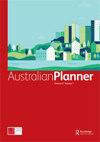Well-being and stronger communities
IF 1.5
Q2 Social Sciences
引用次数: 1
Abstract
The planning and design of urban environments facilitates the meeting of their basic day to day living needs of access to shelter, food and water, waste disposal, clean environments, employment and community infrastructure. But, in a dramatically changing world, urban design and planning also influence many more aspects of people’s quality of life within towns and cities which lead to the possibility of good, and hopefully even better, productive, happy, healthy, meaningful lives, as individuals and as communities. Increasingly the evolving body of neuro-scientific knowledge helps us understand better the range of human needs that ‘go beyond the basics’, and how they are constant while varying in relative emphasis among people. And so that knowledge must surely underpin ways in which thoughtful committed planning and design in a changing urban world can help meet human needs in a diversity of ways. The consultant Neuropower Group identify, for example, six critical needs:福祉和更强大的社区
城市环境的规划和设计有助于满足他们获得住房、食物和水、废物处理、清洁环境、就业和社区基础设施等基本日常生活需要。但是,在一个急剧变化的世界中,城市设计和规划也影响着城镇和城市中人们生活质量的许多方面,从而使个人和社区有可能过上美好的,甚至更好的,富有成效的,快乐的,健康的,有意义的生活。不断发展的神经科学知识帮助我们更好地理解“超越基本”的人类需求范围,以及它们如何在不同人群的相对重点不同时保持不变。因此,在不断变化的城市世界中,这些知识肯定会成为深思熟虑的规划和设计的基础,从而以多种方式帮助满足人类的需求。例如,咨询公司Neuropower Group确定了六个关键需求:
本文章由计算机程序翻译,如有差异,请以英文原文为准。
求助全文
约1分钟内获得全文
求助全文

 求助内容:
求助内容: 应助结果提醒方式:
应助结果提醒方式:


